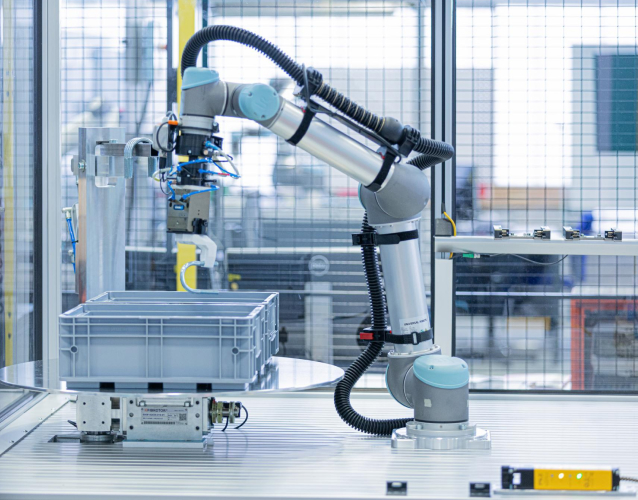FabOS is the open, distributed, realtime-capable, secure operating system for manufacturing


FabOS is the IT backbone for the factory of the future

FabOS provides the foundation for a modern production environment
Milling
- Milled parts require high precision and surface finish.
- Surface finish defects may occur during manufacturing.
- Tools must be replaced preventively to ensure quality.
- A complete check of all components is time-consuming and expensive.






Laser cutting
- Robust, automated removal of parts from the residual grid
- Avoidance of downtimes and manual interventions
- Determination of the removal strategies in advance, without the possibility of modification during production
- Complex part geometries and different material properties
- Need to adapt the removal strategy to different part geometries and material properties




Bin Picking
- Automatic separation of chaotically filled boxes
- High performance for uninterrupted line production
- Automatic identification of unknown parts
- Adaptation to different hardware for commissioning





Measuring
- Missing markings on milled parts make traceability in quality assurance to the manufacturing process difficult.
- The options for loading workpiece carriers are usually ambiguous and provoke errors due to lack of concentration.
- Type, position, orientation and placement accuracy of objects on the workpiece carriers are not available as digital information for subsequent processes.
- Process changes and parameter entries at workstations / machines are made in a less user-friendly manner by keyboard entry.
- Quality assurance in production with random samples is inaccurate or leads to high costs due to 100% inspection.
- The lack of secure data connections to production complicates remote service deployment.










Assembly
- Technical solutions in hand assembly can help reduce human strain
- Quality inspection is important for compliance with quality standards
- DeepInspect uses advanced object recognition methods to assist assembly and check the product for correct assembly.





Stock
- Store floor employees often maintain documents in paper form
- Interaction with digital systems is often cumbersome
- Operation of mobile devices (smartphone, tablet, e-paper) is more difficult due to dirt and gloves
- There is no universal language solution for production conditions (noise, mechanical stress)

























Frequently asked questions
What is FabOS?
FabOS is an open, distributed, real-time capable and secure operating system for production. The operating system is not to be understood in the sense of PC operating systems, but as a platform consisting of coordinated components and services for operating a networked factory. The platform functionalities are based on the principles of classic operating systems.
The development is being carried out as part of the research project of the same name together with companies from business and science. The research project is funded as part of the innovation competition "Artificial Intelligence as a Driver for Economically Relevant Ecosystems" of the Federal Ministry of Economics and Climate Protection (BMWK).
What added value does FabOS offer?
For the first time, FabOS offers an integrated view of OT and IT, i.e., the operating resources and the IT infrastructure as a complete system, to meet the additional requirements of data-driven technologies such as ML or AI-supported applications. Moreover, FabOS is not a closed system from a single provider but an open system that offers easy expandability.
How does FabOS ensure that it is an open solution?
All operating and networking software components are based on open-source technologies and offer freely accessible interfaces. With the help of the asset administration shell, all assets in a factory are described semantically in a standardised way. Proprietary solutions extend the basic functionalities of FabOS and can be obtained via the One Stop Shop.
How can FabOS be used?
FabOS is a research project and is currently under development. The first use cases are being implemented at project partners as part of the research project. In addition, individual parts from FabOS can already be tested today at any time and independently of the research project, as they are available as open source.
How and which standardisation is integrated into FabOS?
Using the asset administration shell as a meta-model for the self-description of assets in FabOS, other existing standards can be easily integrated. The asset administration shell is a technology-independent meta-model for specifying digital images. It is the only standard for implementing Digital Twins nationally/internationally standardised. The meta-model of the asset administration shell can be implemented with different technologies. Thus, depending on the field of application, the appropriate technology can be selected while at the same time guaranteeing semantic interoperability.
































